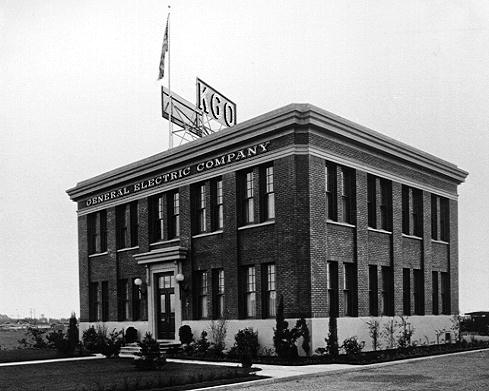
Pacific Coast Station KGO
By R.C. Koernig, Engineer, KGO
March 1924
This is a complete description of the most modern and most powerful broadcast station yet on the air. Full details are given of the apparatus and methods employed.
KGO, the second of three super-broadcasting stations planned by the General Electric Company, came on the air January 8th (1924) on a wavelength of 312 meters. This new station is at Oakland, California, and is intended to serve the entire Pacific Coast. WGY, the first station, at Schenectady, N.Y., has now completed two years of broadcasting, and the third one, yet to be constructed, will be at Denver, Colorado.
The buildings at KGO have been specially constructed to house equipment that is used for popular broadcasting.
The Studio Building
The studio building is a two-story brick structure. On the first floor, near the entrance, is the office of the program manager, and the correspondence room. Opposite these is the reception room where visitors are welcomed. In the rear is a room containing the storage batteries as well as one containing the battery charging generators and plate supply generators for the amplifiers in the control room. A switchboard in this room distributes the power and meters read the voltages and currents at which the various batteries are charging or discharging. A filter system for the amplifier plate generators is also located on this board. The storage batteries and plate supply generators are in duplicate, thus assuring uninterrupted service.

On the second floor are two studios very attractively decorated, the larger being for orchestras, bands, and choruses, while the smaller one is for addresses and solos. The use of these two studios makes continuous broadcasting possible, as artists can be arranged in one studio while the other one is in use.
The walls and ceilings of both studios are covered with a sound-proofing material. Heavy draperies on the walls and thick rugs on the floor also aid in preventing any echo from being received by the microphone. By means of a ventilating system, the air in each studio is kept pure and fresh as the noise of the street outside will not allow the windows to be opened during a program.
On this floor, there is also a room where artists may await their turn on the program. A loud-speaking reproducer allows the artists in waiting to listen to the program.
The Control Room
Between the studios is the control room in which the control apparatus and amplifiers are located.
KGO’s pick-up devices consist of double-button carbon microphones, condenser microphones, and a magnetic type of pick-up. The carbon microphone has been in use for a long time and is the most common type. The condenser microphone requires from one to two additional stages of amplification and operates with a potential of 500 volts between the plates. These amplifiers are placed in the base of the microphone pedestal.
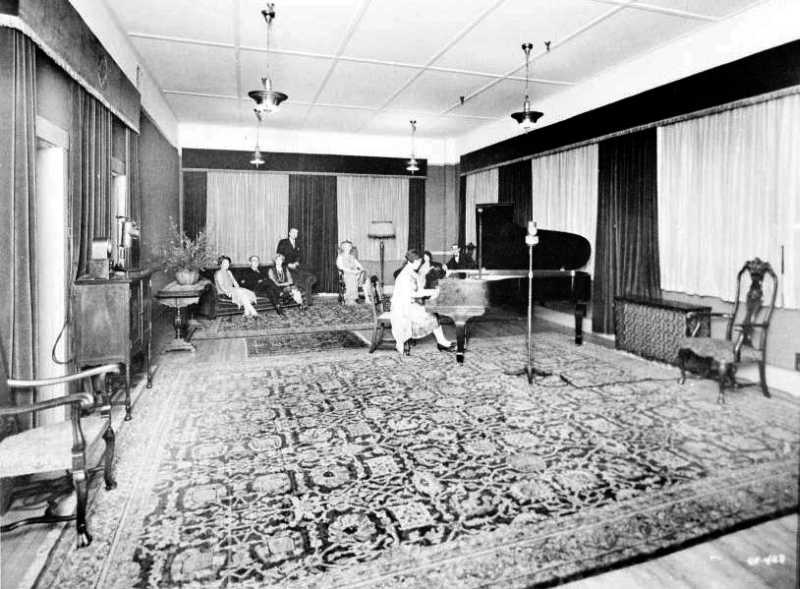
By means of the magnetic type of pick-up individual control of instruments is accomplished. This is particularly true of the piano. The vibrations of the sounding board are transmitted to a rotatable coil which is placed in a strong magnetic field. The voltage thus induced in the coil is placed on the grid of a special first stage amplifier. When this pick-up is used the piano is controlled separately from the vocal selection, which is taken care of by a condenser or double-button carbon microphone.
Microphone outlet boxes and terminal boxes are placed at intervals around the studio behind the draperies. This allows the microphones to be placed in various sections of the room without a long length of wire being stretched across the floor and also connects the control box on the director’s table with the control room.
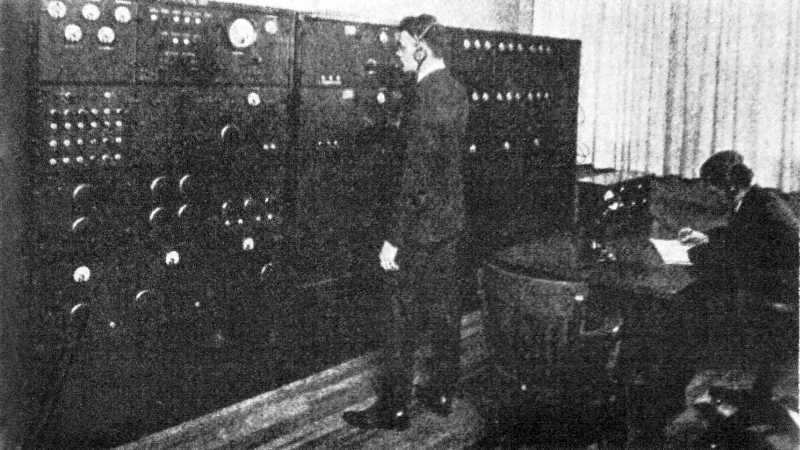
The director’s control box consists of a small key switch which is connected to relays that control the first stage amplifiers. The announcer throws this switch into the “announce” position and the relays connect the announce microphone and its set of amplifiers. While the announcement is being made the senior control room operator prepares the amplifiers for the pick-ups that are to be used in the next selection.
After the announcement has been made the announcer throws the switch to the “concert” position and the relays automatically disconnect the announce microphone and connect the proper concert amplifiers and pick-up devices.
By means of a signal light located in the director’s control box, the announcer in one studio can tell when the number In the other studio is completed and so can proceed with the next part of the program. An interlocking device in the control room prevents both studios from operating at one time.
The microphone circuits from both studios terminate in jacks in the control room. By means of plugs and cords, the microphone is connected to the first stage amplifier. Three different types of first stage amplifiers are utilized and are selected according to the pick-up used.
All the first stage amplifiers are resistance coupled and use UV-202A or UV-210 tubes with a plate potential of 350 to 400 volts. The filaments of all the amplifiers are heated from batteries in the battery room. A bias potential of 5 volts is used on these tubes. Each amplifier has its own filament control, microphone current, and microphone volume controls.
The output of the first stage amplifier is connected to either of the two intermediate amplifier banks. This intermediate amplifier bank consists of two stages of 50-watt tubes in cascade. Both of these stages are resistance coupled and use UV-203A tubes with a plate potential of 750 volts. The filaments are lighted by batteries.
The plate potential of all the tubes is supplied from a generator in the generator room after being properly smoothed and filtered to eliminate any commutator ripple. The third stage amplifier contains a gain control for regulating the output of the control room amplifiers. The output is coupled by means of a transformer to any one of twelve pairs of lines which connect the control room and the power station.
The control panel contains a radio receiver by means of which the senior operator monitors the radio output. If the pick-up has been incorrectly located and the amplifying equipment will not compensate for it, he signals to the director by means of small electric lights placed on the director’s table whether the trouble is in respect to the soloist or accompanist. If possible, the director then makes the necessary change.
The control circuits for the remote control of the plate generator and the batteries are also located on this board, as well as a time signal receiver for re-radiating the government time signals, a small radio oscillator for test purposes, a radio receiver and amplifier for operating a loud-speaking device, and no-click and interlocking relays for both studios with test switches in parallel with the director’s control switch.
The no-click relays prevent the usual click heard in shifting from one pick-up device to another or in disconnecting a microphone from the circuit from appearing in the output. The interlocking relays prevent the use of more than one studio at a time.
Three operators are on duty in the control room during all programs. The senior operator controls the grouping of the amplifiers, operates the gain control, and monitors the radio output. The second man takes the various meter readings at the beginning of each selection and records them in the log. He also assists the senior operator when necessary. The third man listens-in on a wavelength of 600 meters and keeps a log of ship and shore stations, continually on the lookout for a distress call, in which event the station would close down. He is also in control of a 500-watt transmitter adjusted for telegraph operation on 300 or 600 meters located in the power station.
The Power Station
The power station is a one-story stucco building 71 by 32 ft. placed directly beneath one downlead of the multiple-tuned antenna. It is connected to the control room electrically by means of two six-pair lead-covered cables running in metal conduit. These wires terminate in jacks in the operator’s control unit on the control table.
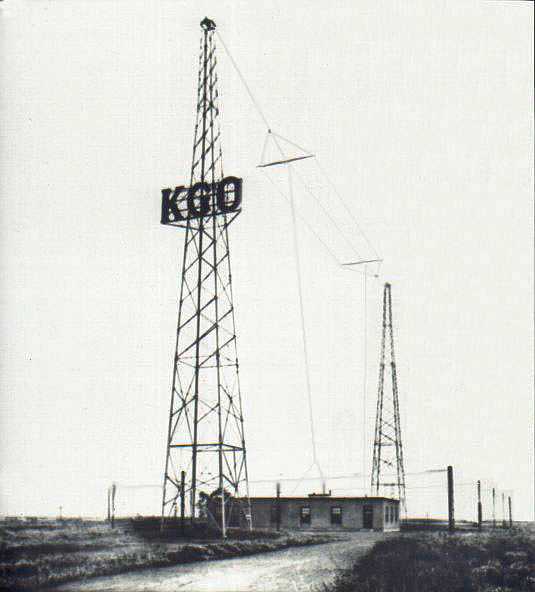
The antenna is of the multiple tuned type with two tuning points and is strung between two towers, 150 ft. in height and 250 ft. apart. A small house beneath the second downlead houses the tuning for that section of the antenna. Beneath the antenna is the counterpoise consisting of twelve wires parallel to the antenna, 15 ft. above the ground, covering an area of 150 by 300 ft. This counterpoise is carefully tuned so that the current in each wire is the same.
The power supply of the station is 2300 volt, 3 phase, 60 cycle alternating current. By means of transformers, this is changed to 110 and 220 volts for distribution.
The generator room of the power station contains nine motor-generator sets. These supply current for heating the filaments of the tubes, plate potential for the power amplifiers and the 600 meter commercial transmitter, bias potential for the amplifier and modulator tubes, and excitation for the various generators. These machines are all in duplicate, thus assuring a continuous program even though a machine should break down.
This room also contains the automatic compensators for starting the alternating current motors that drive the generators and the transformers that supply the A.C. plate potential to the rectifier unit. These transformers contain, besides the high potential windings, a smoothing reactor for smoothing the direct current output of the rectifier, a transformer for supplying filament voltage to the kenetron rectifier, and an interphase reactor which will be described later.
The transformers are in duplicate and a switching arrangement makes possible the use of either one at a moment’s notice.
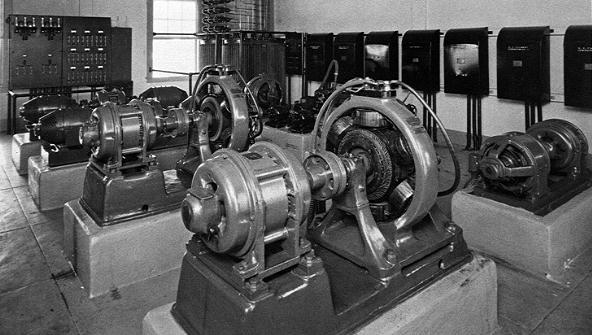
The Transmitters
Two complete transmitters for broadcasting as well as a commercial transmitter adjusted for 300 or 600 meters are in the operating room. A large switchboard is at one end of the room. The controls for starting the machines in the generator room are located on this board, as well as the distribution of the output of the generators. Meters are provided for reading the filament and plate potentials and currents and watt-hour meters for recording the filament life of the tubes.
The output of the control room amplifiers is plugged through the operator’s control unit to either power amplifier for the fourth stage of amplification. This amplifier is also resistance coupled and uses either one or two UV-204A tubes in parallel. The plate potential of the amplifier is from 1500 to 2000 volts depending upon the tube characteristics. The bias potential is between 15 and 30 volts.
In case four stages of amplification are not sufficient to operate the grid of the modulator tube properly, a stage of either one or two UV-203A tubes in parallel can be inserted ahead of the power stage by throwing a three-pole switch in the proper position.

The output of the power amplifier is coupled to the grid of the modulator tube, which is a water-cooled tube of recent design. The modulation system utilized is that commonly known as the plate method of modulation. The bias potential for both the amplifier and the modulator are created in the generator room.
The oscillator which generates the radio-frequency also utilizes one of the water-cooled tubes operating at reduced output. Separate units tune both the grid and plate of the oscillator tube. A tank or dummy circuit is utilized to compensate for the variation in the antenna constants due to a swaying of the antenna. The antenna is loosely coupled to this tank circuit.
The direct current plate potential of both the oscillator and the modulator tubes is obtained from the kenetron rectifier unit. For the plate potential of this rectifier, an auto-transformer varies the supply voltage between 40 and 220 volts, 3 phase, for supply to the delta-connected primary of the transformer. The high tension windings of the two transformers are connected to form two Y’s 180 degrees out of phase. Each Y with its kenetron is thus a half-wave rectifier so 6 phase full-wave rectification is obtained. The midpoints of the Y’s are connected through an interphase transformer which aids the efficiency of the rectifier. The direct current component of the current delivered by each of the Y’s is one-half the total direct current, so each tube only has to pass one-half the maximum value of current required per tube in the ordinary 3-phase full-wave rectifier. The tube equipment consists of six UV-219 kenetrons.

By means of a smoothing reactor and smoothing condensers which are in duplicate, the direct current delivered by the rectifier has less than one-tenth of one percent ripple. The rectifier is capable of delivering 15,000 volts direct current. Only 8000 volts are used on the plates of the oscillator and the modulator tubes.
By working tubes much below their rating, their life is prolonged, the chance of distortion is very much less, and hence the quality of the transmission is improved.
On the operator’s control unit there is a switch that controls a contactor that lights the filaments of the oscillator, modulator and amplifier tubes, starts the cooling systems for the oscillator and modulator tubes, and starts the generator that furnishes bias for the modulator and amplifier tubes. Another switch places plate voltage on the amplifier tube or the commercial transmitter and a third switch, through a contactor, lights the filaments and places plate voltage on the kenetron rectifier unit. The rectifier unit can also be controlled from either oscillator tuning unit or the power distribution board.
A dummy antenna unit having the same constants as the antenna is utilized so that testing can be carried on without putting the radio-frequency into the air.
Both transmitters are kept in readiness so that in case one set or part of one set breaks down the other one can be immediately brought into the circuit.
Two operators are on duty during all programs. The senior operator supervises the operation of the power equipment and sees that each set is resonated to the frequency of 960 kilocycles before the start of the program. This is accomplished by means of a fixed wavemeter which is calibrated and set at this frequency. Very careful watch of this indicator is maintained during the program to make sure that the frequency is constant, for constancy of frequency and continuity of the program are the two vital points in radio broadcasting.
The senior radio operator listens to the output of a radio receiver and also watches the voice wave in an oscillograph. This wave is obtained by means of a small rectifier unit that rectifies radio frequency picked up from the antenna circuit. The small amount of direct current thus obtained is put through an oscillograph vibrator, which is in a strong magnetic field.
By means of a source of light and reflecting prisms, a small mirror on the vibrator deflects light onto a ground glass plate in the front of the oscillograph in proportion to the movement of the vibrator caused by the varying direct current flowing through the magnetic field. A revolving mirror in front of the ground glass plate shows the actual wave. By watching the voice wave, the percentage of modulation is maintained at the proper point.
Should the modulation become too high the operator flashes a signal to the control room operator, who reduces the output of the amplifiers by means of the gain control. Should the percentage of modulation be too low the operator would flash another signal and the output of the amplifiers would be increased. Thus the modulation of KGO is maintained at approximately the same level throughout the program without destroying the delicate shading that an artist or artists give to each selection.
The junior operator records all meter readings in the log at the beginning of each selection. He also watches the motor-generators for hot bearings or sparking brushes and keeps the set resonated by the fixed wavemeter. In the event of a long selection, readings are taken every ten minutes.
KGO is operating at a power of 1000 watts, although for the purposes of testing and experiment this power can be increased.
Remote Broadcasting
KGO will not be limited entirely to its own studio for programs, for, by means of pick-up circuits, church services, dance orchestras, important public gatherings, and theatre productions, as well as athletic contests, can be broadcast.
An operator carefully places the different pick-up devices needed and, during the program or service, switches from one to the other are necessity demands. He controls the output of his one or two stages of amplification which are required to compensate for the losses in the line between the pick-up device and the control room.
Martin P. Rice, director of broadcasting for the General Electric Company, has charge of the new station, as well as WGY at Schenectady and the proposed Denver station. J. A. Cranston, Pacific Coast manager of the General Electric Company, has direct supervision of KGO.
![]()
Source: Radio Magazine, March 1924.
For better views of the photographs, see the Photo Archives section of this website.
[Return to Index of Articles] [Go to Photo Archives] [Return to the Main Menu]
All articles copyright © 1997-2006 by John F. Schneider. All rights reserved.
Reprinted with the generous permission of the author.
![]()

I’ve tried to find the origin or meaning of the KGO call letters., but no luck.
Can you help ? Thanks
David,
Oddly enough, they were issued sequentially – “KGO” was the next three letters after “KGN” and before “KGP”!
Later, General Electric reportedly petitioned the Federal Radio Commission for “KGEO” (standing for, ostensibly, “General Electric Oakland,” since that’s where the station was originally located) but were turned down. As such, they stayed with “KGO.”
– DJ